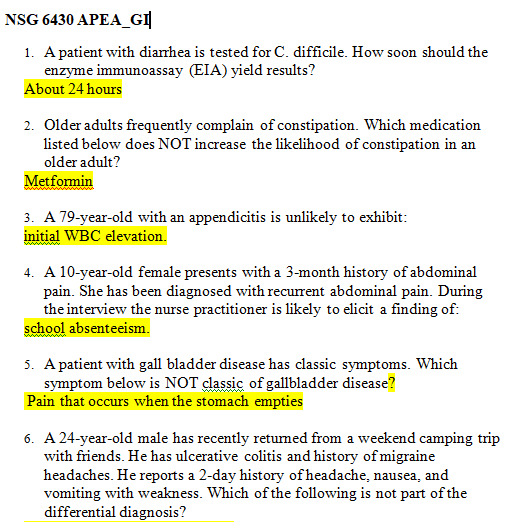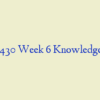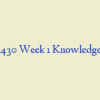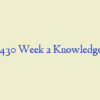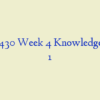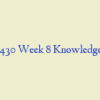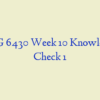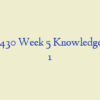Description
NSG 6430 APEA Exam GI (Question and Answers)
- A patient with diarrhea is tested for C. difficile. How soon should the enzyme immunoassay (EIA) yield results?
- Older adults frequently complain of constipation. Which medication listed below does NOT increase the likelihood of constipation in an older adult?
- A 79-year-old with an appendicitis is unlikely to exhibit
- A 10-year-old female presents with a 3-month history of abdominal pain. She has been diagnosed with recurrent abdominal pain. During the interview the nurse practitioner is likely to elicit a finding of
- A patient with gall bladder disease has classic symptoms. Which symptom below is NOT classic of gallbladder disease?
- A 24-year-old male has recently returned from a weekend camping trip with friends. He has ulcerative colitis and history of migraine headaches. He reports a 2-day history of headache, nausea, and vomiting with weakness. Which of the following is not part of the differential diagnosis
- A 45-year-old patient has the following laboratory values. HBsAg positive; anti-HBc positive; anti-HBs negative. How should they be interpreted?
- This patient has a positive hepatitis B surface antigen (HBsAg). Therefore, he has hepatitis B. A positive anti-HBc is …in patients who either have hepatitis now or who have had it. The surface antibody (anti-HBs) would be …..to be negative in a patient with positive surface antigen (HBsAg) because these two markers will not be positive at the same time.
- What medication …..below could be ….to increase appetite in an anorexic patient?
- A patient is in the clinic with a 36- hour history of diarrhea and moderate dehydration. Interventions should include:
- A 56-year-old male patient has been …..with an inguinal hernia. What symptom would make the nurse practitioner suspect an incarcerated hernia?
- A patient asks for advice about a medication that will produce rapid relief if he is having heartburn symptoms. What should the nurse practitioner recommend?
- A patient has a positive hepatitis B surface antibody. This means he:
- An 83-year-old patient is diagnosed with diverticulitis. Where is her pain typically located?
- Many older adults have cachexia. What characterizes this?
- Lovely, an 84-year-old, complains of fecal incontinence. A likely cause is:
- A 40-year-old patient has the following laboratory values. How should they be interpreted? HBsAg negative; anti-HBs positive; anti-HBc negat
- A 40-year-old patient has the following laboratory values. HbsAg negative; Anti-HBc positive; anti-HBs positive. How should they be interpreted?
- A patient has hepatitis B. He probably has a predominance of:
- Which medication listed below can exacerbate the symptoms of GERD?
- Which description is more typical of a patient with acute cholecystitis?
- GERD (gastroesophageal reflux disease) and physiologic reflux have similar characteristics. However, physiologic reflux:
- The three most common causes of bacterial diarrhea in the US are Salmonella, Campylobacter, and:
- A 95-year-old male has lost muscle mass as he has aged. He does not have any underlying disease that has caused this loss. What is this termed?
- A 37-year-old has routine blood work performed during an annual exam. On exam he has a tender, enlarged liver. How should the nurse practitioner proceed?
- A 70-year-old patient states that he had some bright red blood on the toilet tissue this morning after a bowel movement. He denies pain. What is the LEAST likely cause in this patient?
- A 70-year-old presents to the nurse practitioner’s office for a well exam today. What medication probably has no effect on screening for occult blood in the stool?
- Which symptom is INCONSISTENT with irritable bowel syndrome in older adults?
- A 19-year-old female presents with a temp of 100.8°F and lower abdominal pain that began about 12 hours ago. She denies vaginal discharge. Which choice below is the least likely cause of her symptoms?
- An 83-year-old patient is diagnosed with diverticulitis. The most common complaint is:
- The relationship between duodenal ulcer disease and H. pylori infection is:
- A 24-year-old female presents with pain and tenderness in the right lower abdominal quadrant. Her pelvic exam and urinalysis are within normal limits. Her WBC is elevated and her urine pregnancy test is negative. What is part of the differential diagnosis?
- The most common reason that older adults develop peptic ulcer disease is:
- Most patients who have acute hepatitis B infection:
- A 26-year-old female presents with concerns about possible hepatitis C (HCV) infection. She admits to IV drug use 2 months ago and sharing needles with several other people. Initial laboratory studies have been completed. Anti-HCV reactive. How should this be managed?
- A patient has been diagnosed with hepatitis B. The most common reported risk factor is nsg 6430 apea exam
- What medication used to treat patients who have GERD provides the fastest relief of heartburn symptoms?
- Symptoms of uncomplicated reflux disease in older adults should be treated:
- A 26-year-old female complains of pain at McBurney’s point. She feels nauseated. Her vital signs are provided. The most appropriate initial action by the NP is to:
- A 48-year-old patient has the following laboratory values. Anti-HCV reactive; HCV RNA detectable. How should they be interpreted?
- A 3-day-old full-term infant has a bilirubin level of 16 mg/dL. How should this be managed?
- A 6-week-old male infant is brought to the nurse practitioner because of vomiting. The mother describes vomiting after feeding and feeling a “knot” in his abdomen especially after he vomits. The child appears adequately nourished. What is the likely etiology?
- A patient has suspected peptic ulcer disease. Her symptoms occur a few hours after eating. She probably has a(n):
- Which patient has the least worrisome symptoms associated with his diarrhea? One with:
- A 5-year-old female’s playmate has been diagnosed with pinworms. The mother brings her child in for an exam. The 5 year-old denies rectal itching. How should the NP proceed?
- A 35-year-old patient has the following laboratory values. HBsAg negative; anti-HBc negative; anti-HBs negative. How should they be interpreted?
- An 84-year-old presents with a stated involuntary weight loss. He states that he’s lost about 6 pounds in the last 6 or 8 weeks. What statement below is NOT part of the assessment?
- Most patients who have acute hepatitis A infection:
- An older patient presents with left lower quadrant pain. If diverticulitis is suspected, how should the NP proceed?
- A 7-year-old male presents with encopresis. The NP might expect nsg 6430 apea exam
- The initial step in the management of encopresis is:
- Choose the number on the image that most closely approximates the location of a direct inguinal hernia.
- The most common place for indirect inguinal hernias to develop is:
- What is the simplest screen for nutritional adequacy in elderly patients?
- Which of the following is an appropriate initial intervention for gastroesophageal reflux disease (GERD) in an 8-week-old?
- A 42-year-old patient was diagnosed with ulcerative colitis many years ago. What part of his routine health screenings should be stressed by the nurse practitioner?
- A patient presents with complaints of bright red stools over the past week. This symptom could be consistent with:
- A 63-year-old male has been your patient for several years. He is a former smoker who takes simvastatin, ramipril, and an aspirin daily. His blood pressure and lipids are well controlled. He presents to your clinic with complaints of fatigue and “just not feeling well” for the last few days. His vital signs and exam are normal, but his liver enzymes are elevated. His hepatitis panel is negative for infectious hepatitis. What is the most likely cause of his elevated liver enzymes?
- A 20-year-old female patient presents with tenderness at McBurney’s point. Appendicitis is considered. What laboratory test should be done initially to determine the etiology of this patient’s abdominal pain?
- A patient has the following laboratory value. Anti-HAV IgG positive. What is the clinical interpretation?
- The most common place for indirect inguinal hernias to develop is:
- What is the simplest screen for nutritional adequacy in elderly patients?
- A 31-year-old patient is suspected of having hepatitis C. He reports possible exposure about a month ago. How should the nurse practitioner interpret his laboratory results? Anti-HCV nonreactive; HCV RNA not detectable.
- A fecal occult blood test (FOBT) obtained during a rectal examination:
- A healthcare provider (“the HCP”) was stuck with a needle from a patient ….to be ….with HIV (“the patient”). A rapid HIV test was …..on the patient and found to be positive. This means that:
- A 50-year-old with a history of consumption of 3-4 alcoholic drinks daily and weekend binges has elevated liver enzymes. Which set of enzymes is most representative of this patient?
- Which imaging study of the abdomen would be LEAST helpful in diagnosing an acute appendicitis?
- Hirschsprung’s disease is characterized by:
- A mother of a 4-week-old infant visits your office. She states that her baby is vomiting after feeding and then cries as if he is hungry again. What should the nurse practitioner assess?
- Which choice contains three medications that should have liver function tests measured prior to initiation of the medications?
- A patient has been …..with viral gastroenteritis. He has nausea and vomiting, and has started having lower abdominal cramps. What is the most effective intervention for him?
- A 5-year-old has been …..with pinworms. He lives with his mother. There are no other members of the household. How should his mother be managed?
- An older adult has suspected vitamin B12 deficiency. Which of the following lab indices is more indicative of a vitamin B12 deficiency?
- What is true regarding older adults who are overweight nsg 6430 apea exam
- Children with an inguinal hernia:
- An 85-year-old adult has chronic constipation. What is the most likely cause of her constipation?
- The relationship between colon polyps and colon cancer is that polyps
- Which of the following is NOT a risk factor for developing hepatitis B?
- A patient has had right upper quadrant pain that has lasted for the past 3 days, but the pain has become acute in the past 12 hours. He has low-grade fever. Which lab test(s) will be …..if he has pancreatitis?
- An 85-year-old adult has chronic constipation. How should this be managed initially?
- Which term does not characterize hemorrhoids?
- Choose the number on the image that most closely approximates the location of an indirect inguinal hernia nsg 6430 apea exam
- A 43-year-old female patient reports a possible exposure to hepatitis C about 4 months ago.HBsAg negative; Anti-HBc Negative; Anti-HBs positive; anti-HCV nonreactive; HCV RNA not detectable. Which statement is true about this patient?
- Which is NOT an effective strategy for helping older adults gain weight?
- A patient has received a prescriptions for metronidazole for treatment of C. difficile. What should be avoid in this patient?
- A patient has been ….with hepatitis A. The most common ….risk factor is:
- What choice below is most commonly ….with pancreatitis?
- The early signs and symptoms of appendicitis in an adult sg 6430 pea exam
- The most common symptoms associated with gastroesophageal reflux disease (GERD) are heartburn and:
- Which of the following symptoms is typical of GERD?
- A patient presents with right upper quadrant and upper abdominal pain. Acute cholecystitis is …..because the pain radiates to the:
- A patient with a ….inguinal hernia should be examine:
- What medication may be …..to treat GERD if a patient has tried over-the-counter ranitidine without benefit?
- The two tests that can indicate current infection with hepatitis B are:
- The most common cause of diarrhea in adults is:
- A patient has elevated liver enzymes. What is the likely etiology of the elevation?
- A patient has the following lab results. This means nsg 6430 apea exam
- A 14 year-old male patient has an acute, painless groin swelling. Which tool would yield the most information to identify the etiology of the swelling?
- A 15-year-old is about 10% below her ideal body weight. Laboratory studies were……. Which complaint might be common in this patient?
- A patient has the following lab values. HBsAg negative; anti-HBc negative; anti-HBs positive. This indicates that he:
- A patient has the following laboratory values. HBsAg Positive; IgM anti-HBc positive. What does this mean?
- An inguinal hernia is …..on a male patient by an examiner. Which word below best describes what the hernia feels like when touched by the examiner?
- A 20-year-old female patient presents with tenderness at McBurney’s point. What laboratory test supports a diagnosis of appendicitis?
- A patient has the following laboratory values. Anti-HAV IgM Negative; AntiHAV IgG negative. What does this mean?
